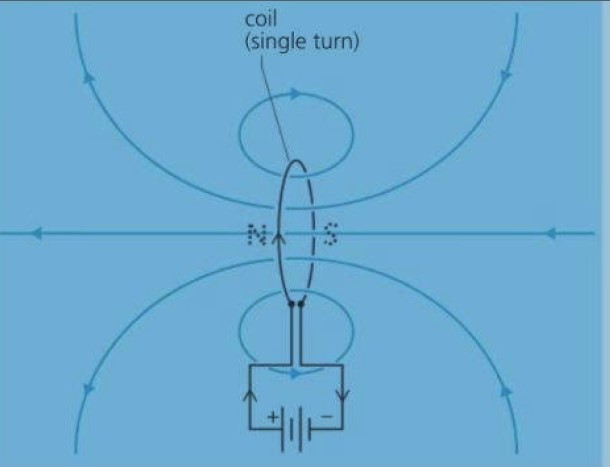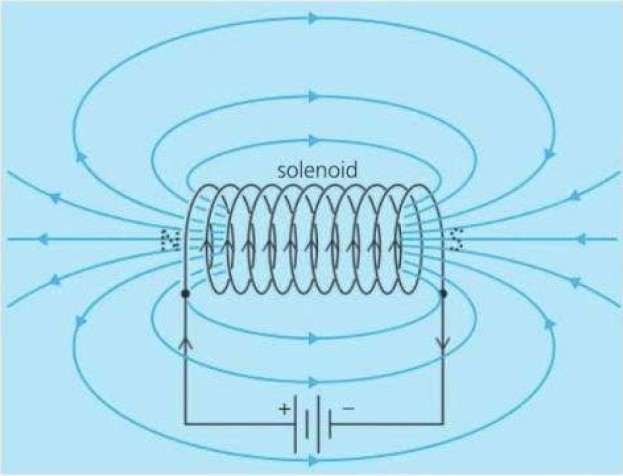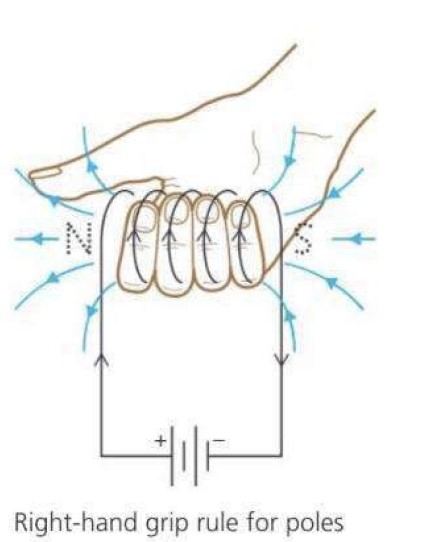Last updated on October 22nd, 2023 at 04:07 pm
यदि करंट प्रवाहित होने वाले तार को एक कुंडल में लपेट दिया जाए तो एक मजबूत चुंबकीय क्षेत्र उत्पन्न होता है। नीचे दिए गए चित्र दो विद्युत धारा प्रवाहित कुंडलियों द्वारा उत्पन्न चुंबकीय क्षेत्र पैटर्न को दर्शाते हैं। एक तार का सिर्फ एक मोड़ है। दूसरी कई घुमावों वाली एक लंबी कुंडली है। लम्बी कुंडली को सोलनॉइड कहा जाता है।
A current produces a stronger magnetic field if the wire it flows in is wound into a coil.
The diagrams below show the magnetic field patterns produced by two current-carrying coils.
One is just a single turn of wire. The other is a long coil with many turns. A long coil is called a solenoid.


धारा प्रवाहित कुंडली (current-carrying coil) द्वारा उत्पन्न चुंबकीय क्षेत्र में ये विशेषताएं होती हैं:
- क्षेत्र एक बार चुंबक के समान है, और कुंडल के सिरों पर चुंबकीय ध्रुव होते हैं
- विद्युत धारा बढ़ने से क्षेत्र की शक्ति बढ़ जाती है
- कॉइल पर घुमावों की संख्या बढ़ाने से क्षेत्र की ताकत बढ़ जाती है।
The magnetic field produced by a current-carrying coil has these features:
– The field is similar to that of a bar magnet, and there are magnetic poles at the ends of the coil
– Increasing the current increases the strength of the field
– Increasing the number of turns on the coil increases the strength of the field.
चुंबकीय ध्रुवों के लिए एक नियम
यह पता लगाने के लिए कि चुंबकीय ध्रुव किस दिशा में हैं, आप एक अन्य दाहिने हाथ पकड़ नियम का उपयोग कर सकते हैं, जैसा कि नीचे दिखाया गया है। अपने दाहिने हाथ से कुंडल को पकड़ने की कल्पना करें ताकि आपकी उंगलियां पारंपरिक विद्युत प्रवाह की दिशा में इंगित करें। तब आपका अंगूठा कुंडल के N ध्रुव की ओर इंगित करता है।
A rule for magnetic poles
To work out which way round the poles are, you can use another right-hand grip rule, as shown below. Imagine gripping the coil with your right hand so that your fingers point in the conventional electric current direction. Your thumb then points towards the N pole of the coil.

